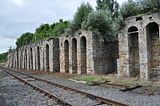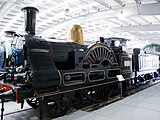Locomotion Museum
 The exterior of the main exhibition hall | |
 | |
Former names | Timothy Hackworth Victorian Railway Museum (until 2004) Locomotion the National Railway Museum at Shildon (2004–2017) |
|---|---|
| Established | 22 October 2004 |
| Location | Shildon, County Durham, England |
| Coordinates | 54°37′27″N 1°37′50″W / 54.6243°N 1.6306°W |
| Type | Railway museum |
| Visitors | 180,697 (2019)[1] |
| Director | Judith McNicol |
| Public transit access | Shildon railway station |
| Website | Museum Website |
| Science Museum Group | |
Locomotion, previously known as Locomotion the National Railway Museum at Shildon, is a railway museum in Shildon, County Durham, England. The museum was renamed in 2017 when it became part of the Science Museum Group.[2]
Overview[edit]
The museum was opened on 22 October 2004 by then Prime Minister and local MP Tony Blair.[3] Built at a cost of £11.3 million, it is based on the former "Timothy Hackworth Victorian Railway Museum". The museum is operated in partnership with Durham County Council and was expected to bring 60,000 visitors a year to the small town. However, during its first six months, the museum attracted 94,000 visits. Locomotion was shortlisted as one of the final five contenders in the Gulbenkian Prize, which is the largest arts prize in the United Kingdom.
As part of the 2025 plans for the National Railway Museum, a second building will be built to house more of the wider collection.[4] In addition, parts of the original museum including the coal drops will be restored having fallen out of use.
Site[edit]
The museum is sited near Timothy Hackworth's Soho Works on the world's first public railway, the Stockton and Darlington Railway (opened on 27 September 1825 with a train hauled by Locomotion No 1 which took 2 hours to complete the 12-mile (19 km) journey from Shildon to Darlington). The town was to become a major centre for British railway engineering thanks to the Shildon wagon works, which closed in 1984.[5]
Shildon station, on the Tees Valley Line was rebuilt and modernised as part of the museum's construction and is actually situated adjacent to the trail and demonstration rail line through the museum site. It is served by all services on the line, operated by Northern.
Museum landmarks[edit]
The museum is arranged as stops along the 1-kilometre (0.6 mi) demonstration line with station direction board signs and information points on the trail between the car parks and the main collection building. The museum has a six-spur apron in front of the main shed and another short length of track for showing off resident locomotives and visiting trains.
The trail starts at the 19th-century welcome building. The original Sans Pareil was previously on display here (It has since been moved to the Collection Building). The second building is Timothy Hackworth's house.[6] It contains several activities about the history of Shildon. Soho is a stone building that was a railway workshop, having originally been an iron merchant's store. The fourth stop is the former goods shed for the town, with most incoming and outgoing goods being delivered to the railway by horse and cart. The building is built partially from recycled stone sleeper blocks, the old fixing slots being visible in the wall.[7]
The railway station's parcel office is the next part of the trail and at the junction, visible across the tracks are the former stables for the early horse-drawn wagonways that linked to the line. The coal drops were a refuelling point for steam locomotives. Wagons were hauled up an incline and the coal 'dropped' down wooden chutes into the tender below.[8][9]
The trail passes under the roadway. There is a children's playground and a picnic area outside the Collection building. The trail ends at the largest building in the museum. It contains the exhibition hall and a conservation workshop with viewing gallery to see the work carried out by volunteers restoring some of the exhibits. Other facilities in the building include interactive games, a cafe and shop.
Exhibits[edit]
The museum is home to several locomotives from the National Collection, including a replica of Timothy Hackworth's Sans Pareil. The original engine, built to compete in the Rainhill Trials, is also at Shildon. The trials were to decide which engine should operate the passenger railway between Liverpool and Manchester. After a 175 years absence from the town, the locomotive was returned and is displayed in the Collection building.[10] LNER Class A4 4468 Mallard which is usually displayed in the NRM's York museum was temporarily displayed in the museum from June 2010 to July 2011.[11] In 2014, ahead of the 75th-anniversary celebrations for Mallard's setting the world steam speed record, 8,000 visitors turned up to welcome five sister A4 locomotives including 60008 "Dwight D Eisenhower" and 60010 "Dominion of Canada" that were repatriated from North America, the latter was given a cosmetic overhaul in Shildon's workshop.
The main exhibition building houses most of the collection and includes the sole examples of the prototype APT-E and Deltic units.[12] The museum has a wind turbine which provides power to the National Grid and an on-site biodiesel bus for transporting visitors around the site.
The NRM recommends checking with them in advance if going to see a particular exhibit.[13]
| Class | Number
(and name if applicable) |
Livery | Image | Current
Status |
Additional Notes |
|---|---|---|---|---|---|
| Hunslet Austerity 0-6-0ST | 3850 Juno | Green | 
|
Static | New to Stewarts & Lloyds ironstone quarries, Buckminster |
| SR Battle of Britain Class | 34051 Winston Churchill | BR Lined Green | 
|
Static | Hauled Winston Churchill's Funeral Train |
| LMS Stanier Class 5 4-6-0 | 5000 | LMS Lined Black | 
|
Static | First Black Five in class |
| Locomotion | 1 Locomotion | Wood lagged |  |
Static | Original built for Stockton and Darlington Railway |
| Locomotion replica | 1 Locomotion | Wood lagged |  |
Moved here from Head of Steam – Darlington Railway Museum in March 2021.[14] | |
| NER Class C1 | 65033 | BR Black | 
|
Static (awaiting restoration) | |
| LNER Class V2 | 4771 Green Arrow | LNER Apple Green | 
|
Static (potential restoration opportunity) | |
| Sans Pareil replica | Sans Pareil | Green and Yellow painted wood | 
|
Static | |
| Timothy Hackworth entry for Rainhill Trials | Sans Pareil | Exposed Metal | 
|
Static | |
| LNWR Class G2 | 49395 | BR Black | 
|
Static | |
| Hetton colliery railway locomotive | Lyon | Black | 
|
Static | |
| NER Class M1 | 1621 | NER Apple Green | 
|
Static | |
| GNR Class C1 (large boiler) | 251 | GNR Apple Green | 
|
Static | Now moved to a museum in Doncaster[15] |
| LSWR 0298 Class (Beattie well tank) | 30587 | BR Black | 
|
||
| South African Class 7A 4-8-0 | 390 | Black | 
|
Static | Cape Gauge |
| LNWR Improved Precedent Class | 790 Hardwicke | LNWR Lined Black | 
|
Static | |
| Andrew Barclay fireless locomotive | Imperial No. 1 | Imperial Paper Mills Green | 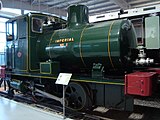
|
Static |
| Class | Number
(and name if applicable) |
Livery | Image | Current
Status |
Additional Notes |
|---|---|---|---|---|---|
| LNER Class ES1 Electric Shunter | 1 | NER Lined Green | 
|
Static | |
| British Rail Class 03 Shunter | D2090 (03090) | BR Green | 
|
Operational | |
| British Rail Class 08 Shunter | 08911 Matey | BR Blue with NRM branding | 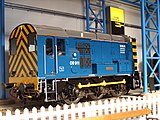
|
Operational | |
| English Electric DP1 | DP1 DELTIC | Blue with grey lining | 
|
Static | Prototype Deltic |
| British Rail Class 41 (HST) | 41001 | Reverse BR Blue & Grey | 
|
Static (awaiting inspection) | Prototype HST power car |
| British Rail Class 43 (HST) | 43102 | InterCity Swallow | 
|
Static | Named "The Journey Shrinker". Holds world speed record for diesel traction, arrived from East Midlands Railway |
| British Rail Class 71 | 71001 | BR Blue | 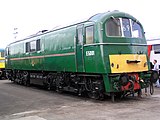
|
Static (under restoration) | |
| British Rail APT-E | APT-E | Reverse BR Blue & Grey | 
|
Static | Gas Turbine |
| Sentinel Diesel-hydraulic Shunter | H001 | RMS Locotec Blue | Static | New to Bass Brewery; rebuilt for CEGB, Haverton Hill | |
| Wickham Trolley | 960209 | BR Brown | 
|
Static | |
| Southern Railway Waterloo & City line Shunter (1898) | 75S | L&SWR Salmon | 
|
Static |
| Class | Number
(and name if applicable) |
Livery | Image | Current
Status |
Additional Notes |
|---|---|---|---|---|---|
| British Rail Class 306 | 306017 | BR Green with yellow warning panel | 
|
Static (awaiting restoration) | Two cars on apron, remaining car behind workshop covered by white tarpaulin. |
| British Rail Class 142 | 142001 | Unbranded Northern | 
|
Operational | |
| British Rail Class 414 | 4308 | Network SouthEast on one side, BR Blue and Grey the other | 
|
Static | |
| British Rail Class 401 | 2090 | BR Green | 
|
Static |
| Class | Number
(and name if applicable) |
Livery | Image | Additional Notes |
|---|---|---|---|---|
| British Railways Mark 1 Brake Corridor Composite Coach | 21274 | BR InterCity | 
|
|
| BR ZZA Snow Plough | ADB 965232 | Network Rail Black | ||
| SR "Queen Mary" brake van | B56283 | BR Brown | 
|
Used at museum for carrying passengers |
| BR merry-go-round train HAA coal hopper wagon | 350000 | BR Grey | 
|
First built HAA wagon (prototype built at Darlington) |
| BR merry-go-round train HAA coal hopper wagon | 368459 | Last built of 10,702 HAA wagons (built at Shildon) | ||
| NER Snow Plough | Snow Plough No. 12 | NER Brown | 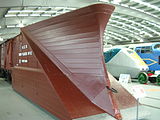
|
|
| Compagnie Internationale des Wagons-Lits Night Ferry Sleeping Car | 3972 | CIWL Blue | 
|
|
| High Speed Freight Vehicle | HSFV1 | Grey | 
|
Basis for Class 142 chassis |
| Stockton and Darlington Railway Composite Coach (1847) | 59 | S&DR Brown | 
|
|
| Stockton and Darlington Railway Composite Coach (1846) | 31 | S&DR Brown | 
|
Formerly displayed at Stockton station. |
See also[edit]
- List of British railway museums
- List of transport museums
- B&O Railroad Museum (US)
- Exporail (Canada)
- Nuremberg Transport Museum (Germany)
- Workshops Rail Museum (Australia)
Notes[edit]
- ^ "ALVA - Association of Leading Visitor Attractions". www.alva.org.uk. Retrieved 9 November 2020.
- ^ "Locomotion Reaches 2.5M Visitor Milestone". Retrieved 22 July 2022.
- ^ "Prime Minister opens Shildon Locomotion museum" The Railway Magazine issue 1244 December 2004 page 5
- ^ "Our Future: Vision 2025". Locomotion. Retrieved 7 April 2022.
- ^ Coulls 2012, p. 3
- ^ Coulls 2012, p. 27
- ^ Coulls 2012, p. 38
- ^ Coulls 2012, p. 5
- ^ Coulls 2012, p. 23
- ^ Coulls 2012, p. 5
- ^ Coulls 2012, p. 18
- ^ Coulls 2012, p. 52
- ^ "Objects and stories". Locomotion. Retrieved 8 February 2020.
- ^ "WATCH: Locomotion No 1 arrives in Shildon". The Northern Echo. Retrieved 15 May 2021.
- ^ "Historic loco takes up residence in Doncaster as first ever heritage engine in town's museums". www.doncasterfreepress.co.uk. Retrieved 25 January 2021.
References[edit]
- Coulls, Anthony (1 February 2012). Spirit of Locomotion: The National Railway Museum at Shildon. Spirit of Britain. Halsgrove. ISBN 9780857100641.
External links[edit]
- Museum website
- The official National Railway Museum print website containing many vintage posters and prints from the museum's collections




